This plant is seen in every garden and often along the roads where it does not look very appealing because it was introduced from America to all tropical areas for its highly decorative dark red foliage. It adapts so well that it often escapes cultivation to colonize abandoned lands. Standing at approximately 1.50 meters tall, when not maintained, it forms sparse clumps of stems with a twisted appearance. It is characterized by its opposite purple leaves and globular white bracts that stand at the end of a long stalk. Its seeds can remain dormant for a long time, partly explaining its good adaptation capabilities. In Laos, where it does not yet have a name, although it is widespread in urban areas, it has been observed that it belongs to the same family (Amaranthaceae) as dok sampi (Gomphrena globosa) and a very closely related species; its scientific name was initially Gomphrena brasiliana.
It is known that the floral heads of dok sampi are used, especially in Luang Prabang, to decorate mak beng; those of Alternanthera brasiliana can serve the same purpose, but they are smaller and less round. The main interest of this plant is primarily to create beautiful massifs; however, this requires a minimum of maintenance. If well-watered and regularly trimmed, it can be shaped into various forms, such as hedges or balls, with vibrant colors.
In its native soil, it is a recognized medicinal plant, as indicated by its English name and its Antillean Creole name. It is reputed to be analgesic, anti-inflammatory, and used to heal wounds. It is also part of the traditional preparation of products aimed at repelling pests. Laboratory analyses have partially confirmed these uses.
On la voit dans tous les jardins et même souvent au bord des chemins où elle n’a pas très belle allure, car cette plante a été introduite d’Amérique dans toutes les zones tropicales pour son feuillage rouge foncé très décoratif; elle s’adapte si bien qu’elle s’échappe souvent des cultures pour coloniser les terrains abandonnés. Haute d’à peu près 1m50, elle forme, lorsqu’elle n’est pas entretenue, des touffes maigres de tiges au port tourmenté. Elle est caractérisée par ses feuilles opposées pourpres et par des bractées globuleuses blanches qui se dressent au bout d’un long pédoncule. Ses graines peuvent longtemps rester en dormance ce qui explique en partie ses bonnes capacités d’adaptation. Au Laos, où elle n’a pas encore de nom, bien qu’elle soit très répandue dans les zones urbanisées, on a bien vu qu’elle était de la même famille (Amaranthacées) que dok sampi (Gomphrena globosa) et d’une espèce très voisine; son nom scientifique a d’ailleurs été d’abord Gomphrena brasiliana.
On sait que les têtes florales de dok sampi sont employées, surtout à Luang Prabang, pour décorer les mak beng; celles de Alternanthera brasiliana peuvent avoir le même usage, mais elles sont moins grosses et moins rondes. L’intérêt principal de cette plante est surtout de constituer de très beaux massifs, encore faut-il pour cela un minimum d’entretien; si elle est bien arrosée et taillée régulièrement, on peut lui donner des formes variées, en haies, en boules, aux couleurs éclatantes.
Dans sa terre d’origine elle est une plante médicinale reconnue, comme l’indique son nom anglais et son nom créole antillais. Elle a la réputation d’être analgésique, anti-inflammatoire et on l’emploie pour cicatriser les blessures. Elle entre aussi dans la préparation traditionnelle de produits destinés à éloigner les ravageurs. Des analyses de laboratoires ont en partie confirmé ces usages.
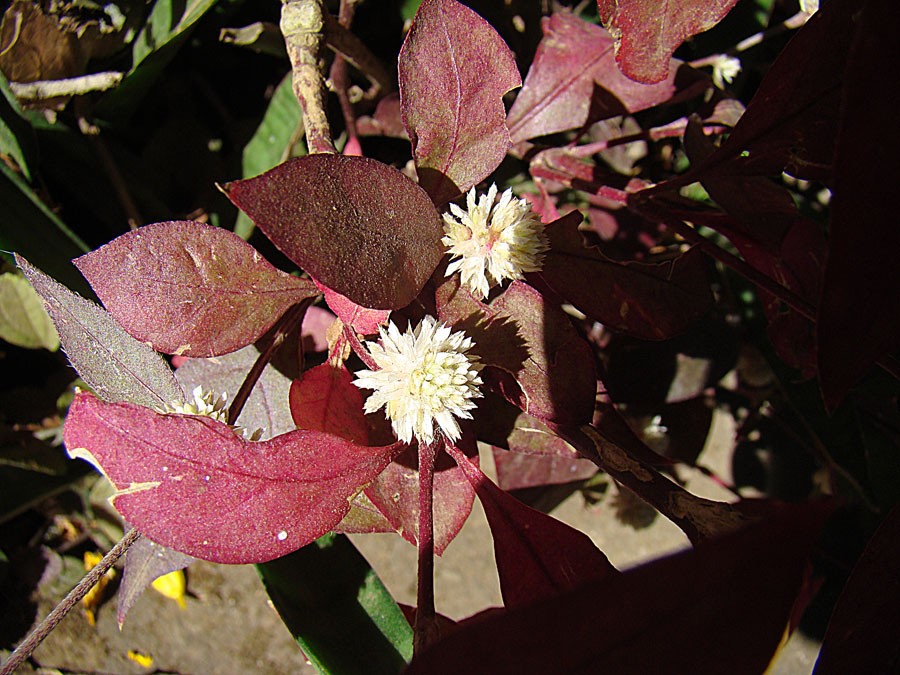
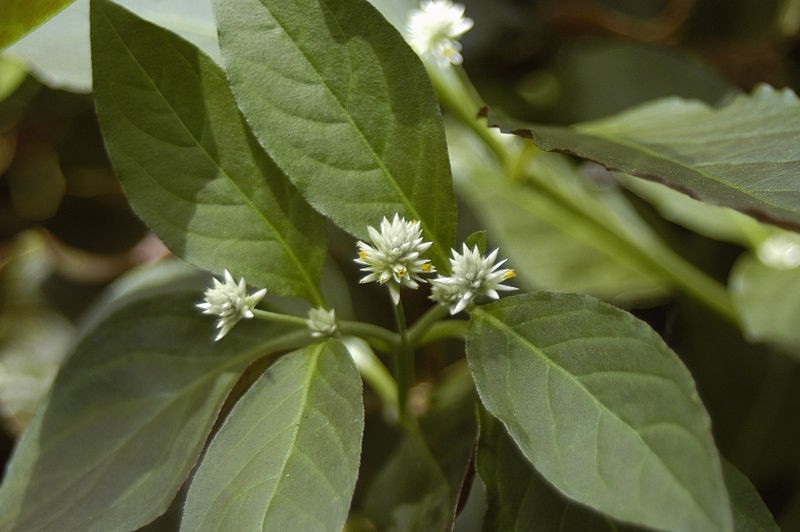
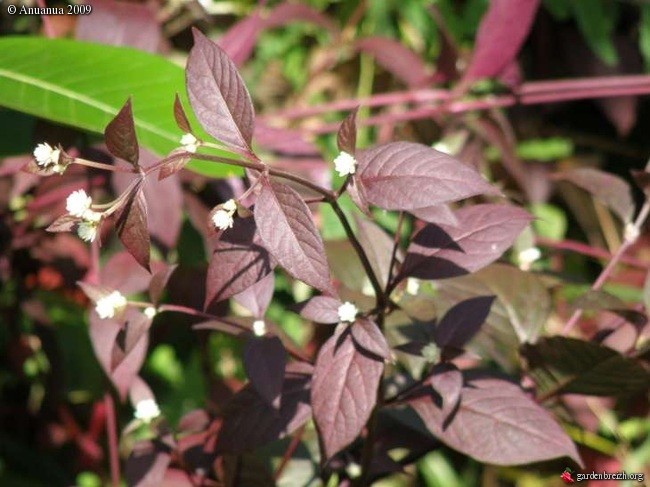
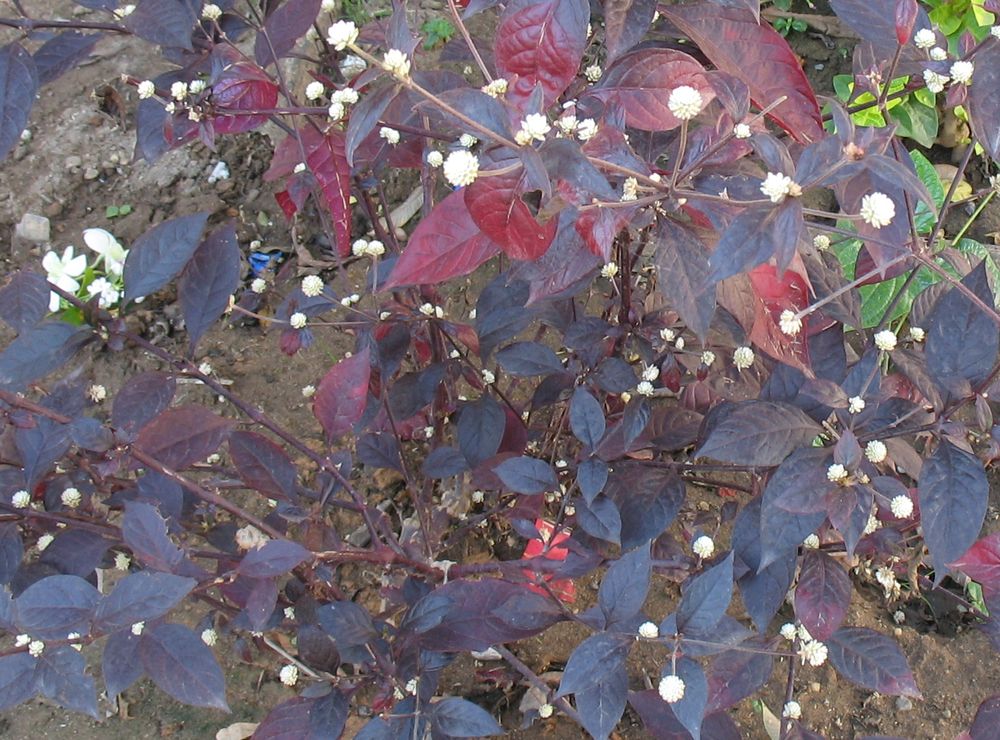
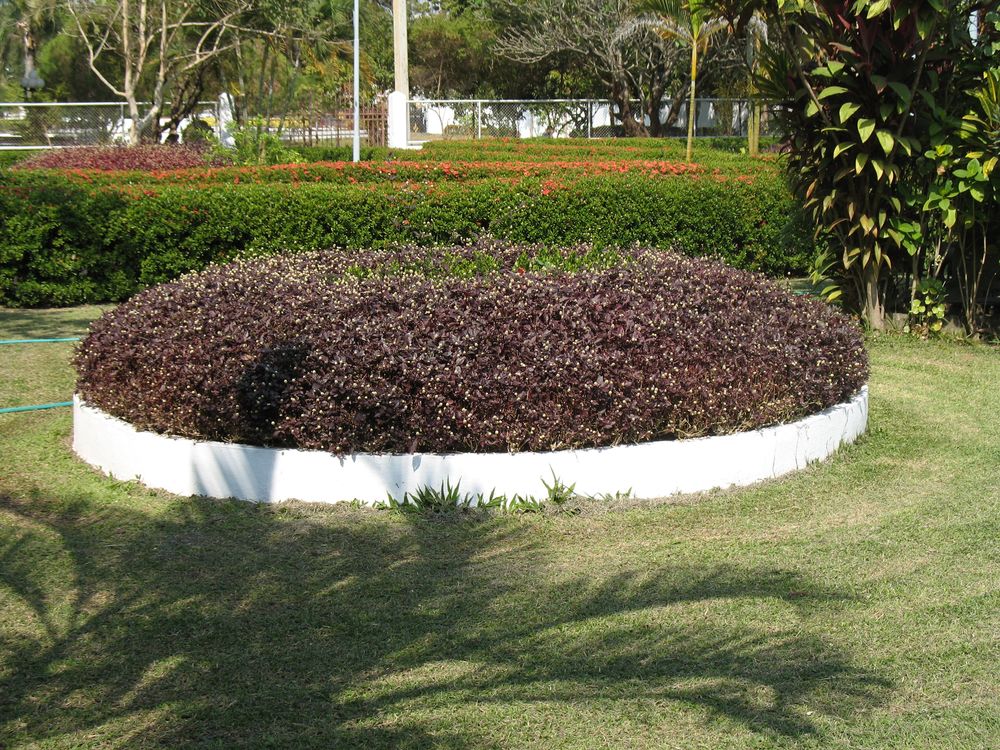
This plant is seen in every garden and often along the roads where it does not look very appealing because it was introduced from America to all tropical areas for its highly decorative dark red foliage. It adapts so well that it often escapes cultivation to colonize abandoned lands. Standing at approximately 1.50 meters tall, when not maintained, it forms sparse clumps of stems with a twisted appearance. It is characterized by its opposite purple leaves and globular white bracts that stand at the end of a long stalk. Its seeds can remain dormant for a long time, partly explaining its good adaptation capabilities. In Laos, where it does not yet have a name, although it is widespread in urban areas, it has been observed that it belongs to the same family (Amaranthaceae) as dok sampi (Gomphrena globosa) and a very closely related species; its scientific name was initially Gomphrena brasiliana.
It is known that the floral heads of dok sampi are used, especially in Luang Prabang, to decorate mak beng; those of Alternanthera brasiliana can serve the same purpose, but they are smaller and less round. The main interest of this plant is primarily to create beautiful massifs; however, this requires a minimum of maintenance. If well-watered and regularly trimmed, it can be shaped into various forms, such as hedges or balls, with vibrant colors.
In its native soil, it is a recognized medicinal plant, as indicated by its English name and its Antillean Creole name. It is reputed to be analgesic, anti-inflammatory, and used to heal wounds. It is also part of the traditional preparation of products aimed at repelling pests. Laboratory analyses have partially confirmed these uses.
On la voit dans tous les jardins et même souvent au bord des chemins où elle n’a pas très belle allure, car cette plante a été introduite d’Amérique dans toutes les zones tropicales pour son feuillage rouge foncé très décoratif; elle s’adapte si bien qu’elle s’échappe souvent des cultures pour coloniser les terrains abandonnés. Haute d’à peu près 1m50, elle forme, lorsqu’elle n’est pas entretenue, des touffes maigres de tiges au port tourmenté. Elle est caractérisée par ses feuilles opposées pourpres et par des bractées globuleuses blanches qui se dressent au bout d’un long pédoncule. Ses graines peuvent longtemps rester en dormance ce qui explique en partie ses bonnes capacités d’adaptation. Au Laos, où elle n’a pas encore de nom, bien qu’elle soit très répandue dans les zones urbanisées, on a bien vu qu’elle était de la même famille (Amaranthacées) que dok sampi (Gomphrena globosa) et d’une espèce très voisine; son nom scientifique a d’ailleurs été d’abord Gomphrena brasiliana.
On sait que les têtes florales de dok sampi sont employées, surtout à Luang Prabang, pour décorer les mak beng; celles de Alternanthera brasiliana peuvent avoir le même usage, mais elles sont moins grosses et moins rondes. L’intérêt principal de cette plante est surtout de constituer de très beaux massifs, encore faut-il pour cela un minimum d’entretien; si elle est bien arrosée et taillée régulièrement, on peut lui donner des formes variées, en haies, en boules, aux couleurs éclatantes.
Dans sa terre d’origine elle est une plante médicinale reconnue, comme l’indique son nom anglais et son nom créole antillais. Elle a la réputation d’être analgésique, anti-inflammatoire et on l’emploie pour cicatriser les blessures. Elle entre aussi dans la préparation traditionnelle de produits destinés à éloigner les ravageurs. Des analyses de laboratoires ont en partie confirmé ces usages.










This plant is seen in every garden and often along the roads where it does not look very appealing because it was introduced from America to all tropical areas for its highly decorative dark red foliage. It adapts so well that it often escapes cultivation to colonize abandoned lands. Standing at approximately 1.50 meters tall, when not maintained, it forms sparse clumps of stems with a twisted appearance. It is characterized by its opposite purple leaves and globular white bracts that stand at the end of a long stalk. Its seeds can remain dormant for a long time, partly explaining its good adaptation capabilities. In Laos, where it does not yet have a name, although it is widespread in urban areas, it has been observed that it belongs to the same family (Amaranthaceae) as dok sampi (Gomphrena globosa) and a very closely related species; its scientific name was initially Gomphrena brasiliana.
It is known that the floral heads of dok sampi are used, especially in Luang Prabang, to decorate mak beng; those of Alternanthera brasiliana can serve the same purpose, but they are smaller and less round. The main interest of this plant is primarily to create beautiful massifs; however, this requires a minimum of maintenance. If well-watered and regularly trimmed, it can be shaped into various forms, such as hedges or balls, with vibrant colors.
In its native soil, it is a recognized medicinal plant, as indicated by its English name and its Antillean Creole name. It is reputed to be analgesic, anti-inflammatory, and used to heal wounds. It is also part of the traditional preparation of products aimed at repelling pests. Laboratory analyses have partially confirmed these uses.
On la voit dans tous les jardins et même souvent au bord des chemins où elle n’a pas très belle allure, car cette plante a été introduite d’Amérique dans toutes les zones tropicales pour son feuillage rouge foncé très décoratif; elle s’adapte si bien qu’elle s’échappe souvent des cultures pour coloniser les terrains abandonnés. Haute d’à peu près 1m50, elle forme, lorsqu’elle n’est pas entretenue, des touffes maigres de tiges au port tourmenté. Elle est caractérisée par ses feuilles opposées pourpres et par des bractées globuleuses blanches qui se dressent au bout d’un long pédoncule. Ses graines peuvent longtemps rester en dormance ce qui explique en partie ses bonnes capacités d’adaptation. Au Laos, où elle n’a pas encore de nom, bien qu’elle soit très répandue dans les zones urbanisées, on a bien vu qu’elle était de la même famille (Amaranthacées) que dok sampi (Gomphrena globosa) et d’une espèce très voisine; son nom scientifique a d’ailleurs été d’abord Gomphrena brasiliana.
On sait que les têtes florales de dok sampi sont employées, surtout à Luang Prabang, pour décorer les mak beng; celles de Alternanthera brasiliana peuvent avoir le même usage, mais elles sont moins grosses et moins rondes. L’intérêt principal de cette plante est surtout de constituer de très beaux massifs, encore faut-il pour cela un minimum d’entretien; si elle est bien arrosée et taillée régulièrement, on peut lui donner des formes variées, en haies, en boules, aux couleurs éclatantes.
Dans sa terre d’origine elle est une plante médicinale reconnue, comme l’indique son nom anglais et son nom créole antillais. Elle a la réputation d’être analgésique, anti-inflammatoire et on l’emploie pour cicatriser les blessures. Elle entre aussi dans la préparation traditionnelle de produits destinés à éloigner les ravageurs. Des analyses de laboratoires ont en partie confirmé ces usages.


